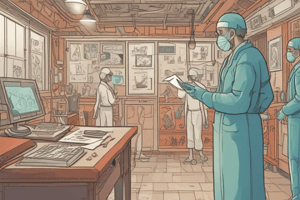Podcast
Questions and Answers
What is the term for hazards that are naturally occurring and cannot be controlled?
What is the term for hazards that are naturally occurring and cannot be controlled?
- Cultural Hazards
- Natural Hazards (correct)
- Lifestyle Hazards
- Biological Hazards
Which type of hazard is associated with bad habits such as smoking and excessive drinking?
Which type of hazard is associated with bad habits such as smoking and excessive drinking?
- Cultural Hazards
- Biological Hazards
- Chemical Hazards
- Lifestyle Hazards (correct)
What is the term for toxic chemicals in the environment, such as asbestos and heavy metals?
What is the term for toxic chemicals in the environment, such as asbestos and heavy metals?
- Cultural Hazards
- Biological Hazards
- Chemical Hazards (correct)
- Natural Hazards
Which type of hazard is characterized by traditions and practices that are ingrained in societal norms?
Which type of hazard is characterized by traditions and practices that are ingrained in societal norms?
What is the term for pathogens that are good for the body and can be found in food such as yogurt?
What is the term for pathogens that are good for the body and can be found in food such as yogurt?
How many pathogens are known to infect humans?
How many pathogens are known to infect humans?
What percentage of existing human infectious diseases are zoonotic?
What percentage of existing human infectious diseases are zoonotic?
Which of the following is an example of a vector that transmits disease?
Which of the following is an example of a vector that transmits disease?
What is the main difference between contagious and infectious diseases?
What is the main difference between contagious and infectious diseases?
What is the size range of bacteria?
What is the size range of bacteria?
Which of the following is a characteristic of viruses?
Which of the following is a characteristic of viruses?
What is the main difference between local and non-localized diseases?
What is the main difference between local and non-localized diseases?
What is the main characteristic that distinguishes viruses from living organisms?
What is the main characteristic that distinguishes viruses from living organisms?
What is a potential risk of self-medication with antibiotics?
What is a potential risk of self-medication with antibiotics?
What is the main difference between anti-viral and anti-bacterial drugs?
What is the main difference between anti-viral and anti-bacterial drugs?
Why is it important to know the mechanism or cause of a health crisis when using anti-microbial drugs?
Why is it important to know the mechanism or cause of a health crisis when using anti-microbial drugs?
What is the primary reason why antibiotics are ineffective against viral infections?
What is the primary reason why antibiotics are ineffective against viral infections?
What is the consequence of the irresponsible use of antibiotics?
What is the consequence of the irresponsible use of antibiotics?
What is the primary goal of the One Health Approach initiated in 2004?
What is the primary goal of the One Health Approach initiated in 2004?
Which organization is mainly focused on animal welfare?
Which organization is mainly focused on animal welfare?
What is health, according to the World Health Organization?
What is health, according to the World Health Organization?
What is a characteristic of being physically healthy?
What is a characteristic of being physically healthy?
What is the relationship between human health and the environment, as highlighted by the pandemic?
What is the relationship between human health and the environment, as highlighted by the pandemic?
What is a characteristic of being mentally healthy?
What is a characteristic of being mentally healthy?
What is the primary driver of biodiversity according to the concept of natural selection?
What is the primary driver of biodiversity according to the concept of natural selection?
What level of ecology refers to a particular area with specific climate or vegetation?
What level of ecology refers to a particular area with specific climate or vegetation?
What is the term for the variety of habitats, communities, and ecological processes?
What is the term for the variety of habitats, communities, and ecological processes?
What is the level of ecology that refers to a portion of a biome, including interactions between living and nonliving organisms?
What is the level of ecology that refers to a portion of a biome, including interactions between living and nonliving organisms?
What is the process that changes the frequency of an existing gene variant within a population by chance?
What is the process that changes the frequency of an existing gene variant within a population by chance?
What is the term for a change or alteration in the whole genetic sequence?
What is the term for a change or alteration in the whole genetic sequence?
Flashcards are hidden until you start studying
Study Notes
Types of Pathogens
- Viruses: smaller than bacteria, invade cells, take over genetic machinery, and duplicate themselves (e.g., AIDS, Flu)
- Bacteria: larger in size, contain different organelles, have metabolic functions, can self-reproduce, and survive on their own (e.g., Tuberculosis, UTI)
- Parasites: can be roundworms, head lice, or protozoa (unicellular organisms)
- Fungi: can be zoonotic (transmissible from animals to humans)
Infectious Diseases
- Defined as when a pathogen invades the body and multiplies in its cells and tissues
- Examples: Tuberculosis, flu, malaria
- Contagious illnesses are caused by germs
- Direct contact: body fluids, blood transfusion, droplets
- Via vectors: living organisms that carry certain types of disease/pathogen (e.g., Dengue disease)
- Vehicle: non-living organisms that transport a pathogen from one person to another (e.g., food vectors transmit Hepa B and C, raw meat, airborne)
Antibiotics and Self-Medication
- Antibiotics should only be prescribed by a doctor
- Do not self-medicate, as it can lead to:
- Wrong self-diagnosis
- Adverse reactions
- Incorrect dosage
- Anti-microbial/biotic resistance
Anti-Microbial/Biotic Resistance
- Occurs when germs develop the ability to defeat the drugs designed to kill them
- Happens naturally due to germ evolution, but can be sped up by irresponsible use of drugs
- Affects both viruses and bacteria
Ecology and Biodiversity
- Levels of ecology:
- Biosphere: living and non-living organisms in the entire earth
- Biomes: particular areas with specific climate or vegetation (e.g., marine, tundra, grasslands, desert, forest)
- Ecosystem: portion of biome, interactions between living and non-living organisms
- Community: either/or non-living or living organisms
- Population: one specific organism in a particular area
- Organism/individual: one particular organism
- Why biodiversity occurs:
- Natural selection
- Genetic drift
- Mutation
- Levels of biodiversity:
- Ecosystem diversity: pertains to a variety of habitats, communities, and ecological processes
One Health Approach
- Program initiated in 2004 by the World Health Organization
- Connects the health of people, animals, and the environment
- Goal: design and implement programs, policies, legislation, and research to achieve better public health outcomes
- Main organizations: World Health Organization, Food and Agriculture, World Health Organization for Animal Health, and United Nations Environment Programme
Human Health and Well-being
- Defined as a state of complete physical, mental, and social well-being
- Not just the absence of disease or infirmity
- In a state of balance and equilibrium
- Physically healthy: no malfunctions, no pain, and able to perform physical activities
- Mentally healthy: not anxious, able to cope with challenges
- Factors that can affect well-being: injury, disease, death, economic loss, or damage
General Categories of Hazards
- Chemical hazards: toxic chemicals in the environment (e.g., asbestos, heavy metals, formalin, plastics)
- Natural hazards: naturally occurring, cannot be controlled (e.g., fire, earthquake, typhoon)
- Cultural hazards: hazards ingrained in societal norms (e.g., female genital mutilation, child marriage, Western diets)
- Lifestyle hazards: bad habits (e.g., smoking, unsafe sex, excessive drinking)
- Biological hazards: can infect humans, particularly if organisms are pathogenic (e.g., germs, 1,400 pathogens that can infect humans)
Studying That Suits You
Use AI to generate personalized quizzes and flashcards to suit your learning preferences.





